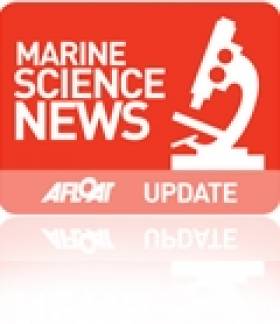Displaying items by tag: Dublin City of Science 2012 Festival
Research Vessels Call to Dublin Bay Ports
#SCIENCE SHIPS – It is a rare to have both Marine Institute research vessels calling at the same time to east-coast ports, as normally these Galway-based ships managed by P&O Maritime Services, work off the rest of the Irish coast, writes Jehan Ashmore.
As previously reported on Aflaot.ie, the RV Celtic Explorer docked in Dublin Port earlier this week. The 65.5m long vessel currently remains moored alongside Sir John Rogersons Quay (berth 6) as the 10-day Euroscience Open Forum 2012 (ESOF) concludes tomorrow in the Convention Centre. High-level delegates from the international scientific community have made the short crossing over the Liffey's Samuel Beckett Bridge to be welcomed on board.
Across Dublin Bay the RV Celtic Voyager had called to Dun Laoghaire Harbour yesterday, where she stayed overnight for a mid-scientific cruise break, while berthed at St. Michaels Wharf. The 31.4m vessel this morning resumed her scheduled Infomar 2 hydrographic work in the Irish Sea.
#MARINE RESEARCH YACHT– The 36m French marine biology research yacht Tara, skippered by Loic Valette, sailed under motor-power into Dun Laoghaire Harbour from Lorient this afternoon, writes Jehan Ashmore.
The two-master is operated by Tara Expeditions which is a non-profit organisation which aims to learn more about the impact of climate change on ecosystems. She has travelled extensively on expeditions to both poles and throughout the world and where the organsiation have collected samples and data to the scientific community.
The port of call is so that she can take part in the Dublin 'City of Science 2012' festival.
Tara will be moored alongside the harbour's East Pier during tomorrow and Thursday, where the public are invited on board to tour the vessel on a first come first served basis. Opening times on both days are between 1-7pm and taken in small groups, noting limited accessibility. Crew will provide guided tours of the class B aluminium built yacht once owned by Jean-Louis Etienne and Sir Peter Blake. For further details click HERE.
As previously reported, the Marine Institute's RV Celtic Explorer docked in Dublin Port today in advance of the ESOF 2012 conference which is the highlight of the year-long science festival. For information visit www.dublinscience2012.ie
RV Celtic Explorer to Visit ESOF 2012
#ESOF IN DUBLIN - The Euroscience Open Forum 2012 (ESOF) is to take place in the Convention Centre in Dublin from tomorrow until next Sunday. As part of the key conference, the Marine Institute's RV Celtic Explorer which docked in the centre of the port today, is expected to relocate berths later in the week for visiting high-level delegates, writes Jehan Ashmore.
The forum is billed as Europe's largest general science conference and the capital was chosen to host the Dublin 'City of Science 2012' festival which is year-long celebration of science. The prestigious international event features over 160 events that will showcase the best of Irish culture, arts and science.
Added to this is a 'Science in the City' festival (6-15th July) which is currently well-under way, for further information visit www.dublinscience2012.ie
French Scientific Schooner to Visit Dun Laoghaire Harbour
#MARINE SCIENCE TALLSHIP- As part of Dublin City of Science 2012, a 'Science in the City' festival (6-15 July) is to include the French scientific expedition schooner Tara, which is to receive a welcoming flotilla on her arrival to Dun Laoghaire Harbour on 10th July, writes Jehan Ashmore.
At only 36m long, the Tara is unique vessel in that she is used for scientific discovery and adventure purposes, as otherwise most such vessels are larger motorships. The schooner is run by the French based non-profit organisation Tara Expeditions that provides samples and data to the scientific community worldwide.
She has accomplished eight expeditions – to the Antarctica, Arctic, Greenland, Patagonia, southern Georgia and throughout the rest of the world. Before her scientific adventure role she was owned by Jean-Louis Etienne and Sir Peter Blake.
Tara Expeditions aim to learn more about the impact of climate change on ecosystems. One of the core objectives is to increase environmental awareness among the general public, and particularly young people through their Tara Junior outreach programme.
She is to be open to the public at her mooring at the harbour's East Pier where her crew will provide guided tours on the 11th and 12th June. Visits on a first come first served basis (between 11am-6pm) where 3 to 4 groups numbering between 8-12 people will be accommodated.
































































